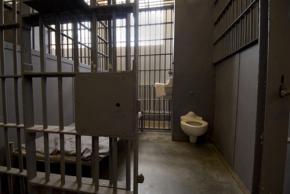Maximum sentence for the minimum crime
With California's budget crisis spiraling out of control, the case of Robert Ferguson shows the twisted priorities of the state's lawmakers, says .
ROBERT FERGUSON'S nearly eight-year prison sentence in early March for shoplifting a bag of shredded cheese from a California convenience store made headlines around the world. How could such a petty crime trigger such a lengthy sentence? Whether from a moral or public policy point of view, the outcome seemed absurd.
But the harsh sentence represents only the final--and perhaps not even the most outlandish--failure of California's criminal justice to deliver justice.
At Ferguson's March 1 sentencing hearing, for example, prosecutors urged the judge to impose a lengthy sentence because of Ferguson's prior convictions. As far as they were concerned, they had already shown leniency by not seeking a life sentence. Prosecutors had only backed down after a psychologist's report concluded that Ferguson suffers from bipolar disorder, which impairs his ability to control impulses during manic phases.
Nevertheless, Deputy District Attorney Clinton Parish still asserted at the hearing that Ferguson is a "career criminal," pointing to his 13 prior convictions that put him behind bars for 22 of the past 27 years.
Never mind that six prior burglary convictions occurred some 30 years ago. Or that Ferguson's misdemeanor assault conviction was for throwing a soda can at a sibling when he was a teenager.
Or that the only reasonable place for a man suffering from mental illness is a mental health facility, not the overburdened California prison system--which a panel of judges two years ago found to be so overwhelmed that it "worsens many of the risk factors for suicide among inmates and increases the prevalence and acuity of mental illness."
Those same judges ordered California to lower its prison population by more than 40,000 inmates so that the system would not exceed 137 percent of its intended maximum capacity of 84,000.
Two years later, the state of California is still staring at one of the highest incarceration rates in the nation and a sprawling prison system that costs the state $10.8 billion--about 10 percent of its annual budget--to house 170,000 prisoners. Today, California spends more to lock people up than it does on the University of California system, once the premier public institution of higher education in the U.S.
BUT ROBERT Ferguson is only the latest in a long history of sentencing outrages stretching back to the 1990s, when voters overwhelmingly passed Proposition 184, mandating a life sentence for anyone convicted of a third felony.
Other cases that made headlines were the 1994 life sentence for Jerry Dewayne Williams, who stole a pizza, and a 25-years-to-life sentence for Johnny Quirino, convicted in 1996 of petty theft of razor blades.
What makes such stories all the more preposterous is the gaping hole in California's budget--in part the product of the rise of California's prison population in the wake of tough sentencing rules such as three-strikes. It costs about $49,000 a year to house an inmate in California's prison system.
The painful cuts facing practically every social service and public institution in California have yet to convince politicians and public-policy makers of the need for a fundamental reform of tough-on-crime laws.
Between the 1970s and the present, California's prison population more than quintupled--from less than 30,000 to around 170,000.
For three decades now, the logic of "getting tough on crime" has justified harsh sentencing laws, a prison-building spree and worsening police brutality. Defenders of the system say that such policies are necessary to deal with the scourge of drugs and violent crime. But they can only do so by ignoring the facts about drug use and crime.
Thus, law-and-order policies have filled the nation's prisons with hundreds of thousands of nonviolent drug offenders, disproportionately Blacks and Latinos, even though whites use illegal drugs at very similar rates.
In the words of Michelle Alexander, author of The New Jim Crow: Mass Incarceration in the Age of Colorblindness:
President Ronald Reagan officially declared the current drug war in 1982, when drug crime was declining, not rising. From the outset, the war had little to do with drug crime and nearly everything to do with racial politics.
The drug war was part of a grand and highly successful Republican Party strategy of using racially coded political appeals on issues of crime and welfare to attract poor and working-class white voters who were resentful of, and threatened by, desegregation, busing and affirmative action.
In the words of H.R. Haldeman, President Richard Nixon's White House Chief of Staff: "[T]he whole problem is really the blacks. The key is to devise a system that recognizes this, while not appearing to."
It's time to stop the runaway freight train of California's prison system--and the whole country's law-and-order drive that incarcerate more people than any nation on the planet.



